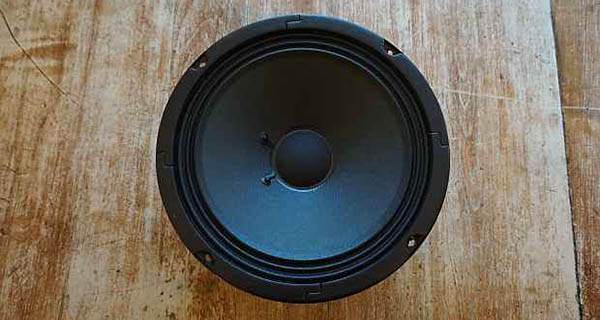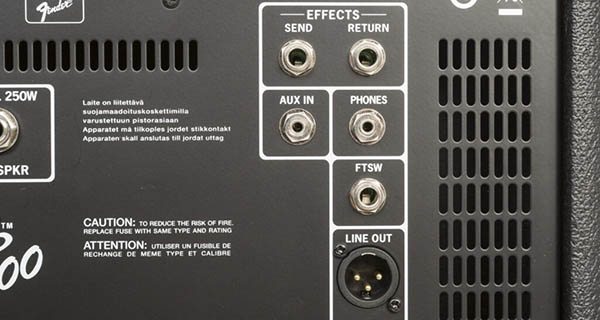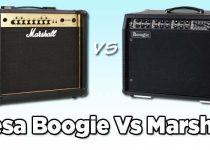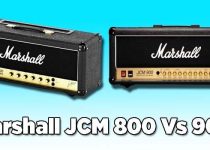Fender Rumble 40 Vs 100 [Difference & Which is better]
Fender, a revered name in the realm of music gear, presents two highly sought-after options in their Rumble series: the Fender Rumble 40 vs 100. These amplifiers have amassed a devoted following among bass players of all levels. Each boasting distinct features and impressive performance capabilities.

In this comprehensive comparison, we will explore the intricacies that differentiate the Fender Rumble 40 and Rumble 100. Empowering you to make an educated decision based on your playing style and sonic preferences. Join us on this journey as we delve into power, tone, versatility, and more, putting the Rumble 40 and Rumble 100 head-to-head in a quest for bass dominance.
# Table of Contents =>
- 0.1 Comparison Table:
- 0.2 Details About The Fender Rumble 40:
- 0.3 Details About The Fender Rumble 100:
- 1 Main Difference Between Fender Rumble 40 Vs 100:
Comparison Table:
| Feature | Fender Rumble 40 | Fender Rumble 100 |
|---|---|---|
| Power | 40 watts | 100 watts |
| Speaker Size | 1 x 10″ | 1 x 12″ |
| Weight | Approx. 18.5 lbs | Approx. 22 lbs |
| Controls | Volume, Overdrive, Bass, Mid, Treble, Contour, Bright | Volume, Overdrive, Bass, Mid, Treble, Contour, Bright |
| Inputs | 1 x 1/4″ Instrument Input, 1 x 1/8″ Aux Input | 1 x 1/4″ Instrument Input, 1 x 1/8″ Aux Input |
| Outputs | 1 x 1/4″ Line Out, 1 x 1/8″ Headphone Out | 1 x 1/4″ Line Out, 1 x 1/8″ Headphone Out |
| Built-in Effects | Overdrive | Overdrive |
| Cabinet Material | Lightweight Plywood | Lightweight Plywood |
| Dimensions (HxWxD) | 16.5″ x 16.5″ x 13.8″ | 18.5″ x 19.5″ x 14″ |
Details About The Fender Rumble 40:

The Fender Rumble 40 stands as a bass amplifier that prioritizes portability without compromising on sound quality. Employing a solid-state design, this amplifier delivers a potent 40 watts of power through a single 10-inch speaker. Here are the key features that make the Rumble 40 a standout choice:
a) Power and Volume:
With 40 watts of power, the Rumble 40 is suitable for rehearsals, small gigs, and practice sessions. While it may not be ideal for larger venues or gigs with a loud drummer, it offers enough volume for most casual playing situations.
b) Lightweight and Portable:
Weighing a mere 18 pounds, the Rumble 40 boasts exceptional portability, making it an ideal companion for musicians on the go or those seeking an amplifier that fits snugly in limited spaces.
c) Versatility:
Equipped with a 3-band EQ (bass, mid, treble), the Rumble 40 offers extensive tonal shaping capabilities. Additionally, an integrated overdrive circuit provides the opportunity to infuse your bass sound with grit and character.
d) Auxiliary Input and Headphone Jack:
Accommodating modern needs, the Rumble 40 features an auxiliary input. It is enabling seamless connections to external devices like smartphones or MP3 players. Furthermore, a headphone jack facilitates silent practice sessions, allowing you to hone your craft without disturbing others.
Details About The Fender Rumble 100:

The Fender Rumble 100 is a step up from the Rumble 40, offering more power, a larger speaker, and additional features. Here’s what sets the Rumble 100 apart:
a) Increased Power and Volume:
Delivering 100 watts of power through a single 12-inch speaker. The Rumble 100 is better suited for medium-sized gigs and rehearsals with a full band. It offers a considerable boost in volume compared to the Rumble 40.
b) Enhanced Speaker Size:
The larger 12-inch speaker contributes to a more robust and fuller sound, particularly in the low-frequency range, providing a deeper bass response.
c) Versatility:
Similar to the Rumble 40, the Rumble 100 features a 3-band EQ and an overdrive circuit for tonal shaping and added character.
d) XLR Line Out:
The Rumble 100 comes with a balanced XLR line-out. That is allowing you to connect directly to a sound system or recording interface. This feature is beneficial for larger gigs and studio recording.
Main Difference Between Fender Rumble 40 Vs 100:
a) Power and Volume:

The most apparent difference between the Rumble 40 and Rumble 100 is their power output and volume capabilities. The Rumble 100 offers double the power of the Rumble 40. Which is making it a more suitable option for larger performances and band settings.
b) Speaker Size:

The Rumble 40 houses a 10-inch speaker, while the Rumble 100 boasts a larger 12-inch speaker. The increased speaker size in the Rumble 100 contributes to a more significant low-end response and a fuller overall sound.
c) Weight and Portability:
Due to its higher power output and larger speaker, the Rumble 100 is slightly heavier than the Rumble 40. While both amplifiers are relatively lightweight and portable, the Rumble 40 may be the preferred choice for musicians who prioritize extreme portability.
d) XLR Line Out:

The Rumble 100 comes equipped with an XLR line-out, providing greater connectivity options for live performances and studio recording. The Rumble 40, on the other hand, lacks this feature.
Performance Comparison: Rumble 40 Vs Rumble 100
When it comes to performance, choosing between the Rumble 40 and Rumble 100 largely depends on your specific needs and playing scenarios.
a) For Practice and Small Gigs:
If you primarily use your bass amplifier for practice sessions, home use, and small gigs in intimate venues, the Rumble 40 is more than sufficient. Its compact size, lightweight design, and versatile tonal options make it an excellent choice for casual playing situations.
b) For Medium to Large Gigs:
If you perform in medium-sized venues or play with a full band, the Rumble 100’s extra power and larger speaker size. It will provide the necessary volume and low-end punch to cut through the mix.
c) Versatility:
Both amplifiers offer similar tonal shaping capabilities with their 3-band EQ and overdrive circuit. While the Rumble 100’s XLR line-out is an advantage for connecting to sound systems and recording gear, it may not be a critical factor for everyone.
d) Budget Consideration:
Price is always a factor to consider. The Rumble 40 is generally more budget-friendly than the Rumble 100, which could be an essential consideration for players on a tight budget.
The Best Choice for You?
The decision between the Fender Rumble 40 vs 100 ultimately boils down to your specific requirements and playing preferences. If you prioritize portability, play in smaller venues, or are conscious of your budget. The Rumble 40 is an excellent option that delivers reliable performance.
However, if you require more power, increased volume, and a deeper low-end response for medium to large gigs, the Rumble 100 is the superior choice.
Consider your playing needs, the venues you perform in, and your budget when making the decision. Both amplifiers are stellar examples of Fender’s commitment to providing exceptional bass amplification, and either one will undoubtedly serve as a valuable tool in your musical journey.
FAQs –
Question-1: Does the Rumble 100 sound significantly louder than the Rumble 40?
Answer: Yes, the Rumble 100 is likely to be noticeably louder than the Rumble 40 due to its higher power output and larger speaker.
Question-2: Are the control options the same on both models?
Answer: Yes, both models offer similar control options including Volume, Overdrive, Bass, Mid, Treble, Contour, and Bright controls, allowing you to shape your tone according to your preferences.
Question-3: Can I use both amplifiers for practice and small gigs?
Answer: Yes, both the Rumble 40 and Rumble 100 are suitable for practice and small gigs. The Rumble 100 might provide a bit more headroom and projection for larger spaces.
Question-4: Can I connect headphones or external devices to both amplifiers?
Answer: Yes, both amplifiers have headphone outputs and auxiliary input options for connecting external devices like phones or music players.
Question-5: Is there a difference in the cabinet material used for these amplifiers?
Answer: Both amplifiers are constructed using lightweight plywood for the cabinet material.
Last Updated on September 14, 2023 by Perry Garner


